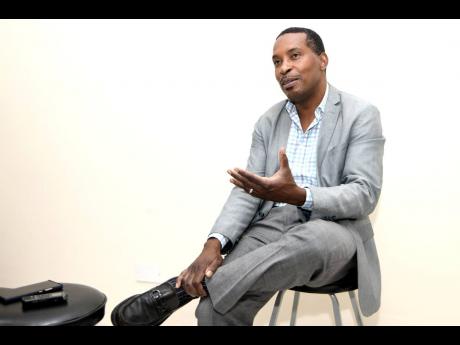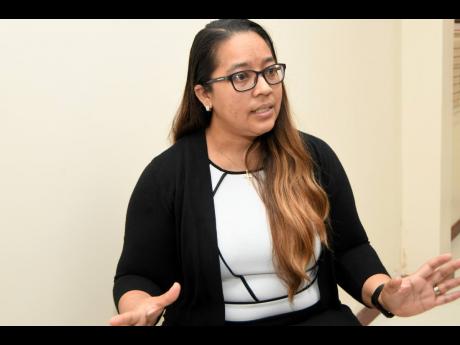Viral terror
• Consultant recalls anguish watching relative, others die from COVID • Care did not come cheap, notes hospital administrator
As Jamaica’s COVID-19 positivity rate returns to double-digit territory, the island’s medical professionals are looking on with bated breath after finally being able to get a breather following the island’s deadliest and traumatic two waves of the...
As Jamaica’s COVID-19 positivity rate returns to double-digit territory, the island’s medical professionals are looking on with bated breath after finally being able to get a breather following the island’s deadliest and traumatic two waves of the pandemic between last summer and early this year.
As admissions peaked over the last two waves, bringing many public hospitals above capacity, the country’s teaching hospital – the University Hospital of the West Indies (UHWI) – also buckled under pressure with staff and space constraints amid feverish attempts to maintain an adequate supply of medical-grade oxygen.
Taking a moment to reflect recently, Dr Kathy-Ann Pate-Robinson, a consultant in infectious diseases at UHWI, told The Sunday Gleaner that her family of four all contracted the virus.
She believed she contracted it five days after receiving her booster shot, and tell-tale signs of headaches, back pains, joint discomfort, runny nose and general malaise began manifesting soon after.
Doctors, she recalled, were very terrified of becoming infected by their patients, and it led to anxiety, depression or both.
Two years later, she cannot wait to tell the pandemic goodbye.
FEAR
“There was a lot of fear and trepidation among the medical staff,” said Pate-Robinson, who said her own anxiety peaked each time she was removing protective gear, carefully following guidelines to avoid contracting SARS-CoV-2, the virus which causes COVID-19.
Many periods of separating from her family out of fear of taking the virus home led to depression.
“I think I started to get a little depressed, but wasn’t necessarily recognising that that was happening,” Pate-Robinson said. “Sometimes when you are depressed, you don’t have any drive to do your usual things. It was the small things – like, ‘Can I just sleep on the couch and not my bed?’ or ‘Do I need to bathe?’, these small things – because you don’t understand the impact of these lower level of separation that my patients would go through.”
She recalled how painful it was for the first three women who were hospitalised at the St Andrew-based facility, housed on an otherwise empty ward for almost a month, and attended to in spacesuit-like gear. One was separated from her toddler, who was placed in quarantine, and both mother and child cried non-stop, causing distress to both, as well as the medical team.
“The mom with the young child was crying most days. Another lady couldn’t take it any more. It’s not like now of 10 to 14 days [before being discharged]. They were there for at least a month. She just started bawling and just dragged herself all over me and I had to hug her. Her tears ran down my neck,” recalled the infectious disease expert, who, although part of her brain told her this was not good, another part told her she had to be human.
She was not infected from the interaction.
“I know there were some staff members who were traumatised by being on COVID care, some who were on antidepressants and anti-anxiety medications ... . Some were not recommended for duties because of how they were impacted. Doctors are humans, too,” she said.
DEADLY DOSES
While COVID-19 is not a direct cause of depression and anxiety, she said the social isolation from the lockdowns made many, especially the elderly, agoraphobic – fearful of going outside. That plus the fear of crime and violence were deadly doses, she said.
And in the face of so many deaths from the disease – some she witnessed – the legs given to conspiracy theories and other fanciful thoughts were disconcerting.
“I saw patients suffer, struggle and die alone from COVID,” Pate-Robinson said, immediately breaking down in tears, recalling how she helplessly witnessed her own relative dying while she was on duty.
“I had to be the go-between for them and the rest of the family because I was the only person present. I remember the level of depression they suffered being away from family, and I couldn’t be there for them the way I wanted to because we had other infectious cases on the ward that I would be dealing with and had contacts with other infectious cases that made it unsafe for me to be in contact with them,” she told The Sunday Gleaner.
“That was hard. It was very hard to watch them die ... ,” she said through tears.
With a mysterious liver disease now affecting children mainly in the United Kingdom – which experts are looking into to determine whether it has links to COVID-19, although the United States-based Centers for Disease Control and Prevention has cast doubt on that theory – Pate-Robinson says Jamaicans should not start to worry but instead keep healthy daily habits – indoors and outdoors – even in eating.
“I can’t tell you what it is. I don’t think anyone knows as yet. Something that pops up in multiple places in the pattern that it has makes you suspicious that it is infectious, especially when you have a rash of cases, except it is a chemical exposure. So we will have to wait and see what precautions are required,” she advised.
The doctor believes that far more Jamaicans were infected with COVID-19 than the numbers show, but cautioned that, “The longer you go from your most recent exposure, your immune ability to fight the virus is going to wane.”
She said at this point, there is a good level of immunity in the population, but no one knows if COVD-19 boosters will not become routine going forward.
She recalled that the chikungunya (Chik-V) virus had caught Jamaica unaware years ago, but swiftly swept across the island, providing herd immunity. The more infections, along with vaccinations, will provide immunity, but three generations from now, the situation will be repeated as the immunity pool would have shrunk significantly.
“If everybody in Jamaica become infected with COVID, then the virus will die in a few weeks as there will be no one to infect. So the only way it will replicate is if a new strain comes into play or new vulnerable people. We don’t really know what the reservoirs for this virus are, whether animals or other organisms and continue to live without dying out; we don’t really know,” she said.
Already, some countries have given double boosters to the already boosted and local experts believe protection begins to wane 25 weeks after administration.
Roughly $20m per person to treat worst cases
Dr Carl Bruce, chief of medical staff at UHWI, believes he and his family were fortunate, largely because of precautions taken both at home and work. Assistance received from colleagues around the world were also helpful for staff.
“We instituted a mask mandate long before it became a policy, and that’s the advice from the network of persons we have who have trained here and [are] operating in different parts of the world. It was unpopular at first, but we did it,” he told The Sunday Gleaner.
At the peak of the pandemic, when the Delta variant raged, Jamaicans were traumatised by the images of persons seeking care being treated on makeshift wards, benches, and chairs, while some were housed on mattresses on the ground in over-capacity hospitals. Public hospitals across the island also began treating emergency cases only amid a crippling wave of infection.
The cost of care drilled a huge hole in many hospital budgets.
“We think it cost more than $20 million per person to treat those who were worst infected,” Bruce said.
“If you look at all the advanced drugs that they get, the amount of oxygen, the equipment, plus we were doing advance and experimental care, harvesting antibodies from plasma. We had to use special machines – thanks to corporate Jamaica, we acquired those machines – then we had to process those and give them to patients who were most vulnerable,” he told The Sunday Gleaner.
“So the process did not come cheap. We used resources that we could have given to heart or cancer patients,” he declared.
The fear factor was real, he noted.
“Right across the world fear was the major concern and certainly here. There was also major concerns about the availability of oxygen during the second surge. We had staff strategically locating cylinders around the hospital, on staircases at various critical points in case there was systemwide shortage. We went very close to that,” Bruce said.
MAINTAINED STOCKS
Working closely with oxygen suppliers allowed the UHWI to maintain stock, although it came perilously close to running out at points.
There was also genuine fear among medics about donning and doffing (putting on and removing personal protective equipment), Bruce said.
Pleased by the strong will of his team, he said they were prepared to use bags to ventilate patients with their hands should it come to that, and he credited those who came out on their days off to help amid the crisis.
“That is something you cannot train. It’s done out of deep love and shows the patient-centric approach taken,” he said.
He said no one could have predicted the scale of the impact on the health system, despite the signs.
Two years ago, in the same Peter Fletcher Lecture Theatre, where this interview was conducted, the hospital’s head of medicine, Professor Michael Boyne, predicted that COVID-19 would be bigger than the September 11, 2001 terrorist attack in the United States.
Bruce said the COVID-19 emergency care brought challenges to other patients needing urgent attention for other serious ailments.
“While we had the COVID emergency, many of the families of those who wanted us to manage the COVID patients forgot about the others who did not have COVID, but had just as critical emergencies. So when you had a heart attack, stroke or ruptured appendix, brain haemorrhage or some other emergencies, they still needed care, and so the hospital still had to be dynamic in caring for all,” he explained.
Despite those challenges, beds were reserved for those patients and the $50 million private-sector field hospital, which was spearheaded by the RJRGLEANER Communications Group, provided 48 additional spaces.
Like Pate-Robinson, Bruce believes that more Jamaicans have been infected with COVID-19 than official numbers reflect.
With more than 90 per cent of admitted patients unvaccinated, both doctors strongly advocated for Jamaicans to take the jab. Doctors have led by example, with about 90 per cent of them vaccinated islandwide.
“If we vaccinate, we are able to extend the healthcare dollar to treating other diseases,” Bruce noted.
Despite the lifting of the mask mandate, the protective gear is still required for staff and visitors at UHWI. Vaccinations are also continuing on site and the testing stations remain open. Trends will inform any future decision on their continuation.


